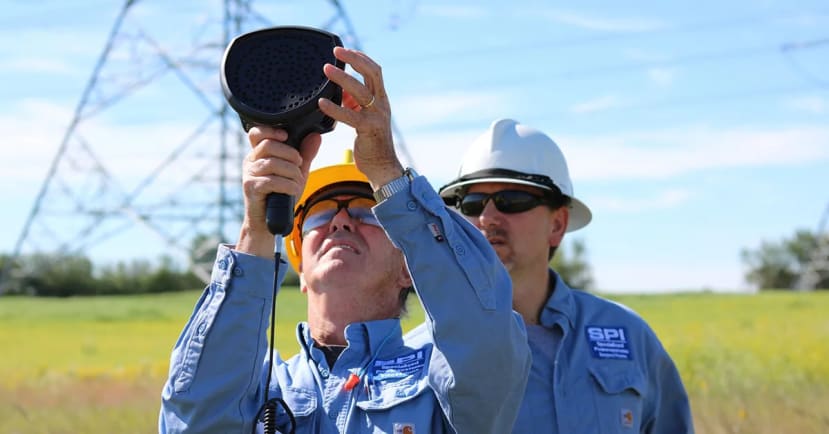Domestic Electricity: Preventing Failures with the FLIR Si124
Follow articleHow do you feel about this article? Help us to provide better content for you.
Thank you! Your feedback has been received.
There was a problem submitting your feedback, please try again later.
What do you think of this article?
The transfer of electricity from the generating station to a domestic property is a complicated and expensive process. From the power station, it is transferred to transformers to increase the voltage, allowing it to be pushed long distances through high-voltage transmission lines that stretch across the country. When the power reaches a substation, the voltage is lowered, allowing it to be sent through smaller power lines. Finally, it travels through distribution lines where the voltage is further reduced making it safe for domestic use.
Each of these steps presents plenty of opportunities for failure if the infrastructure is not properly maintained. To locate and identify potential areas of failure requires a significant level of expertise and the correct cutting-edge technology.
So, let’s take a closer look at some of the technology that makes problem-solving possible and helps to maintain the safe transfer of domestic electricity.
Sulfur hexafluoride is used in circuit breakers in power stations and distribution systems. The gas circuit breakers have the advantage of being quieter and generally lower maintenance than other types of breakers. When sulphur hexafluoride devices start to degrade the gas can be released in extremely low concentrations. The FLIR GF77 gas detection camera can identify ultra-low levels of the sulphur hexafluoride gas making detection of faulty breakers an easy exercise.
Cameras designed to detect sulphur hexafluoride (SF6) gas are not new. A well-established company specialising in electrical infrastructure inspections have been using SF6 detection cameras for many years, however, they say the FLIR GF77 has one distinct feature that makes it the gas detection camera of choice. By simply replacing the front lens the camera can be used to detect other gases associated with the operation of high-voltage electrical systems such as methane, ethylene, ammonia and other gas emissions. As well as having the two separate interchangeable lenses, the FLIR GF77 is also calibrated for temperature, so it functions as a standard thermography camera used to reveal a wide range of utility issues.
A senior engineer states, “It’s the versatility of the FLIR GF77 that is the big attraction for so many field engineers. When working at high elevations, the last thing anyone wants is to have to carry loads of heavy kit, often strapped to your body. The interchangeable lens facility with the FLIR GF77 means a single camera with two small lenses, so much easier from a logistic point of view”.
Further Inspection Tools
It’s not just leaking gas that indicates the malfunctioning of high-voltage electrical systems. When partial discharge occurs, there is often an associated low-level sound, inaudible to the human ear. Imagine a microphone, so sensitive that it can pick up this low-level sound at several metres from the discharge. Multiply this by 124 and the result is the FLIR Si124 acoustic imaging camera. Since its introduction in 2022, the FLIR Si124 has been successfully used around the globe in detecting discharge from many types of electrical equipment. Built with 124 microphones, the Si124 produces a precise acoustic image that visually displays ultrasonic information in real-time on top of a digital camera picture. This allows the user to visually pinpoint the source of the sound. The 124 microphones can detect sound up to 130 metres away from the camera making it extremely useful when dealing with overhead power lines, transformers, and equipment in dangerous and inaccessible areas.
Elton Hunter, a senior engineer with SPI Inspections says, “Following the success with the FLIR GF77 we were keen to use the FLIR Si124 acoustic imaging camera. We weren’t disappointed! So many pieces of equipment we test are in difficult to access areas such as transformers, and motors and circuit breakers in concealed industrial areas etc. In the past, testing would involve engineers having to have access to these areas and we would need to conduct the appropriate risk assessment. More recently, we’ve used drones to pinpoint electrical discharge, however, the downside to this approach is that you need to know where to look and position the drone accordingly. We also have some industrial customers who understandably would not allow drones to be used due to safety issues”.
The amazing range of the FLIR Si124, along with the incredible sensitivity, eliminates the danger associated with assess to difficult areas and has the benefit of allowing production to continue in confined industrial areas. It is an invaluable asset in detecting partial discharge, a sign of approaching or imminent failure in power infrastructure.
Elton continues, “It’s not just the advanced hardware tools that FLIR provide, the software packages that store and analyse the inspection results are invaluable and make reporting so quick. Sending engaging and visual reports to our customers has never been easier”.
Find out more about the FLIR Si124 (261-3768)


Comments